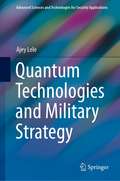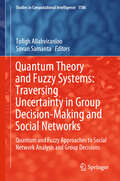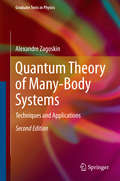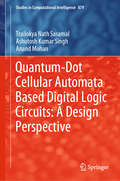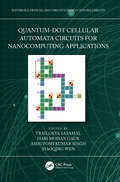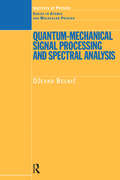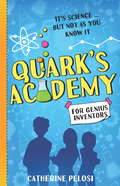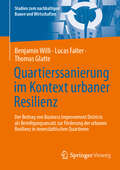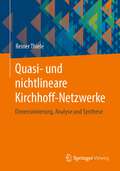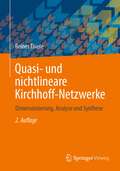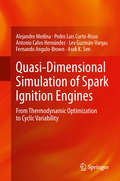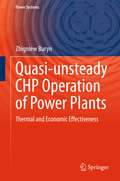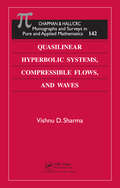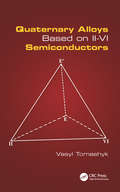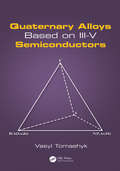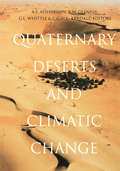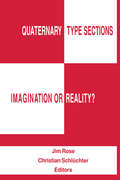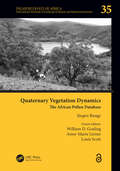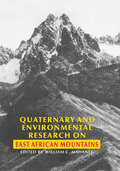- Table View
- List View
Quantum Technologies and Military Strategy (Advanced Sciences and Technologies for Security Applications)
by Ajey LeleThis book is about the strategic relevance of quantum technologies. It debates the military-specific aspects of this technology. Various chapters of this book cohere around two specific themes. The first theme discusses the global pattern of ongoing civilian and military research on quantum computers, quantum cryptography, quantum communications and quantum internet. The second theme explicitly identifies the relevance of these technologies in the military domain and the possible nature of quantum technology-based weapons. This thread further debates on quantum (arms) race at a global level in general, and in the context of the USA and China, in particular. The book argues that the defence utility of these technologies is increasingly becoming obvious and is likely to change the nature of warfare in the future.
Quantum Theory and Fuzzy Systems: Quantum and Fuzzy Approaches to Social Network Analysis and Group Decisions (Studies in Computational Intelligence #1186)
by Tofigh Allahviranloo Sovan SamantaThis book dives into the fascinating intersection of quantum theory and fuzzy systems. This work is inspired by quantum theory and its real-world applications. It bridges the gap between abstract theoretical concepts and practical implementations in quantum theory-based group decision-making and graph theory/social networks. Highlights: Core concepts: Begin with uncertainty in quantum theory and fuzzy systems and familiarise yourself with the basics of quantum graphs. Real-World Applications: Explore methods for multi-attribute group decision-making, choosing green building materials, and evaluating wearable health devices, renewable energy options, and cell phones using quantum decision methods. Advanced Exploration: Investigate dynamic centrality measures for brain networks, routing protocols, centrality metrics, link prediction, and applications of quantum graphs. Comprehensive topics: Learn about green supplier selection, investment decisions under uncertainty, sustainable solar energy management, and more. Innovative approaches: Examine topological indices, dominance theory, applications of quantum computing, social fuzzy and quantum networks, scenarios of co-concurrence, and optimization techniques in quantum graphs. This comprehensive guide is an indispensable resource for students, researchers, and professionals who want to explore the applications of quantum theory in network science, quantum computing, and decision-making. Whether readers are experts or novices, this book provides knowledge and practical insights to navigate the complexity of uncertainty in our networked world.
Quantum Theory of Many-Body Systems
by Alexandre ZagoskinThis text presents a self-contained treatment of the physics of many-body systems from the point of view of condensed matter. The approach, quite traditionally, uses the mathematical formalism of quasiparticles and Green's functions. In particular, it covers all the important diagram techniques for normal and superconducting systems, including the zero-temperature perturbation theory and the Matsubara, Keldysh and Nambu-Gor'kov formalism, as well as an introduction to Feynman path integrals. This new edition contains an introduction to the methods of theory of one-dimensional systems (bosonization and conformal field theory) and their applications to many-body problems. Intended for graduate students in physics and related fields, the aim is not to be exhaustive, but to present enough detail to enable the student to follow the current research literature, or to apply the techniques to new problems. Many of the examples are drawn from mesoscopic physics, which deals with systems small enough that quantum coherence is maintained throughout their volume and which therefore provides an ideal testing ground for many-body theories.
Quantum Transport in Interacting Nanojunctions: A Density Matrix Approach (Lecture Notes in Physics #1024)
by Andrea Donarini Milena GrifoniThis book serves as an introduction to the growing field of quantum many-body transport in interacting nanojunctions. It delves into a theoretical approach based on a general density-matrix formulation for open quantum systems. In the book, relevant transport observables, like the current or its higher order cumulants, are obtained by evaluating quantum statistical averages. This approach requires the knowledge of the reduced density matrix of the interacting nanosystems. The formulation for addressing transport problems, based on the evolution of the reduced density operator in Liouville space, is highly versatile. It enables the treatment of charge and spin transport across various realistic nanostructures. Topics encompass standard Coulomb blockade, cotunneling phenomena in quantum dots, vibrational and Franck-Condon effects in molecular junctions, as well as many-body interference observed in double quantum dots or carbon nanotubes. Derived from lectures tailored for graduate and advanced students at the University of Regensburg in Germany, this book is enriched with exercises and step-by-step derivations.
Quantum Transport: Atom to Transistor
by Supriyo DattaThis 2005 book presents a unique approach to the fundamentals of quantum transport, and is aimed at senior undergraduate and graduate students. Some of the most advanced concepts of non-equilibrium statistical mechanics are included and yet no prior acquaintance with quantum mechanics is assumed. Chapter 1 provides a description of quantum transport in elementary terms accessible to a beginner. The book then works its way from the hydrogen atom to nanostructures ending with a unified model for quantum transport along with illustrative examples showing how conductors evolve from the atomic to the ohmic regime (or from 'atom to transistor') as they get larger. Many numerical examples are used to provide concrete illustrations and the corresponding MATLAB codes are provided in the book. These codes, along with videostreamed lectures by the author, keyed to specific sections of the book, are available at the webpage for the book - under 'resources and solutions'.
Quantum and Blockchain for Modern Computing Systems: Quantum and Blockchain Technologies: Current Trends and Challenges (Lecture Notes on Data Engineering and Communications Technologies #133)
by Ajith Abraham Adarsh Kumar Sukhpal Singh GillThis book states that blockchain technology provides a secure distributed, peer-to-peer, and decentralized network with advanced cryptography primitives and protocols. The important question that arises in the quantum computing world is to test the existing blockchain networks against quantum attacks and design quantum computing enabled secure blockchain solutions. This book encourages professionals from different fields to provide blockchain and quantum technology-integrated solutions that incorporate low-cost, effective QoS, fast, secure, and futuristic demands. This book has surveyed and proposed approaches that improve quantum computing and cryptography protocols. Quantum computing and quantum science are not just helpful in software but the hardware world as well. To design networks with quantum science, quantum-enabled devices like quantum memories and quantum repeaters can be useful to demonstrate for organizations. For example, designing a single quantum repeater for long-distance quantum communication is useful in reducing the network cost, and ensuring better security levels. This book has introduced the quantum computing and blockchain technology aspects, their integration approaches and future directions.
Quantum-Dot Cellular Automata Based Digital Logic Circuits: A Design Perspective (Studies in Computational Intelligence #879)
by Anand Mohan Ashutosh Kumar Singh Trailokya Nath SasamalThis book covers several futuristic computing technologies like quantum computing, quantum-dot cellular automata, DNA computing, and optical computing. In turn, it explains them using examples and tutorials on a CAD tool that can help beginners get a head start in QCA layout design. It discusses research on the design of circuits in quantum-dot cellular automata (QCA) with the objectives of obtaining low-complexity, robust designs for various arithmetic operations. The book also investigates the systematic reduction of majority logic in the realization of multi-bit adders, dividers, ALUs, and memory.
Quantum-Dot Cellular Automata Circuits for Nanocomputing Applications (Materials, Devices, and Circuits)
by Xiaoqing Wen Ashutosh Kumar Singh Trailokya Nath Sasamal Hari Mohan GaurThis book provides a composite solution for optimal logic designs for Quantum-Dot Cellular Automata based circuits. It includes the basics of new logic functions and novel digital circuit designs, quantum computing with QCA, new trends in quantum and quantum-inspired algorithms and applications, and algorithms to support QCA designers. Futuristic Developments in Quantum-Dot Cellular Automata Circuits for Nanocomputing includes QCA-based new nanoelectronics architectures that help in improving the logic computation and information flow at physical implementation level. The book discusses design methodologies to obtain an optimal layout for some of the basic logic circuits considering key metrics such as wire delays, cell counts, and circuit area that help in improving the logic computation and information flow at physical implementation level. Examines several challenges toward QCA technology like clocking mechanism, floorplan which would facilitate manufacturability, Electronic Design Automation (EDA) tools for design and fabrication like simulation, synthesis, testing etc. The book is intended for students and researchers in electronics and computer disciplines who are interested in this rapidly changing field under the umbrella of courses such as emerging nanotechnologies and its architecture, low-power digital design. The work will also help the manufacturing companies/industry professionals, in nanotechnology and semiconductor engineers in the development of low power quantum computers.
Quantum-Dot-Based Semiconductor Optical Amplifiers for O-Band Optical Communication
by Holger SchmeckebierThis thesis examines the unique properties of gallium arsenide (GaAs)-based quantum-dot semiconductor optical amplifiers for optical communication networks, introducing readers to their fundamentals, basic parameters and manifold applications. The static and dynamic properties of these amplifiers are discussed extensively in comparison to conventional, non quantum-dot based amplifiers, and their unique advantages are elaborated on, such as the fast carrier dynamics and the decoupling of gain and phase dynamics. In addition to diverse amplification scenarios involving single and multiple high symbol rate amplitude and phase-coded data signals, wide-range wavelength conversion as a key functionality for optical signal processing is investigated and discussed in detail. Furthermore, two novel device concepts are developed and demonstrated that have the potential to significantly simplify network architectures, reducing the investment and maintenance costs as well as the energy consumption of future networks.
Quantum-Mechanical Signal Processing and Spectral Analysis (Series in Atomic Molecular Physics)
by Dzevad BelkicQuantum-Mechanical Signal Processing and Spectral Analysis describes the novel application of quantum mechanical methods to signal processing across a range of interdisciplinary research fields. Conventionally, signal processing is viewed as an engineering discipline with its own specific scope, methods, concerns and priorities, not usually encompassing quantum mechanics. However, the dynamics of systems that generate time signals can be successfully described by the general principles and methods of quantum physics, especially within the Schroedinger framework. Most time signals that are measured experimentally are mathematically equivalent to quantum-mechanical auto-correlation functions built from the evolution operator and wavefunctions. This fact allows us to apply the rich conceptual strategies and mathematical apparatus of quantum mechanics to signal processing. Among the leading quantum-mechanical signal processing methods, this book emphasizes the role of Pade approximant and the Lanczos algorithm, highlighting the major benefits of their combination. These two methods are carefully incorporated within a unified framework of scattering and spectroscopy, developing an algorithmic power that can be exported to other disciplines. The novelty of the author's approach to key signal processing problems, the harmonic inversion and the moment problem, is in establishing the Pade approximant and Lanczos algorithm as entirely algerbraic spectral estimators. This is of paramount theoretical and practical importance, as now spectral analysis can be carried out from closed analytical expressions. This overrides the notorious mathematical ill-conditioning problems with round-off errors that plague inverse reconstructions in those fields that rely upon signal processing. Quantum-Mechanical Signal Processing and Spectral Analysis will be an invaluable resource for researchers involved in signal processing across a wide range of disciplines.
Quark's Academy
by Catherine PelosiSCIENCE IN PROGRESS - ENTER AT YOUR OWN RISK!Junior science geniuses Augustine, Celeste and Oscar can't believe their luck when they're accepted into an elite and mysterious science academy summer camp run by the elusive Inventor Quark.From the moment they step inside the gates of Quark's Academy at the end of Molecule Drive, they know they're in for a week they'll never forget. But things at the academy are not quite what they seem, and the three quickly realise that they'll need to put their squabbles aside and their heads together if they're ever to get out of there alive...A page-turning adventure for readers aged eight to twelve, QUARK'S ACADEMY is bound to cause a hair-raising reaction!'an engaging and entertaining debut for readers aged eight and up with an interest in STEM - or those who just love a well-paced adventure story with fantastical elements.' 4.5 stars - BOOKS + PUBLISHING
Quartierssanierung im Kontext urbaner Resilienz: Der Beitrag von Business Improvement Districts als Beteiligungsansatz zur Förderung der urbanen Resilienz in innerstädtischen Quartieren (Studien zum nachhaltigen Bauen und Wirtschaften)
by Thomas Glatte Lucas Falter Benjamin WilliStädte und ihre Quartiere sind Transformationsprozessen unterworfen und stehen nach Krisen wie der Corona-Pandemie vor großen Herausforderungen. Diese Publikation aus der Reihe „Studien zum nachhaltigen Bauen und Wirtschaften” untersucht in welcher Konstellation und unter welchen Bedingungen Business Improvement Districts (BIDs) als ein Beteiligungsinstrument der Quartiersentwicklung für die Stärkung der urbanen Resilienz eingesetzt werden können. Dabei wird auch der Frage nachgegegangen wer für die Umsetzung resilienter Stadtentwicklung verantwortlich ist und was konkret in einem Quartier resilient gestaltet werden soll.
Quasi- und nichtlineare Kirchhoff-Netzwerke: Dimensionierung, Analyse und Synthese
by Reiner ThieleDas Buch vermittelt neuartige Analyse- und Syntheseverfahren für quasi- und nichtlineare Kirchhoff-Netzwerke. Hierzu verwendet der Autor als Unternetzwerke gewöhnliche Widerstände, Kondensatoren, Spulen, Übertrager, Transistoren oder Dioden sowie die sogenannten pathologischen Unternetzwerke Nullator und Norator. Zur Analyse oder Synthese erfolgt eine Zerlegung der Gleichungen zur Beschreibung des Klemmenverhaltens in die u-i-Relationen realisierbarer Unternetzwerke sowie in Strukturgleichungen nach Kirchhoff. Dazu kreiert Reiner Thiele neue nichtlineare Transistor- bzw. Dioden-Modelle. Außerdem zeigt er, wie durch die Applikation von Klemmen-Äquivalenzen praxisrelevante elektrische oder elektronische Schaltungen entstehen.
Quasi- und nichtlineare Kirchhoff-Netzwerke: Dimensionierung, Analyse und Synthese
by Reiner ThieleDas Buch vermittelt neuartige Analyse- und Syntheseverfahren für quasi- und nichtlineare Kirchhoff-Netzwerke. Hierzu verwendet der Autor als Unternetzwerke gewöhnliche Widerstände, Kondensatoren, Spulen, Übertrager, Transistoren oder Dioden sowie die sogenannten pathologischen Unternetzwerke Nullator und Norator. Zur Analyse oder Synthese erfolgt eine Zerlegung der Gleichungen zur Beschreibung des Klemmenverhaltens in die u-i-Relationen realisierbarer Unternetzwerke sowie in Strukturgleichungen nach Kirchhoff. Dazu kreiert Reiner Thiele neue nichtlineare Transistor- bzw. Dioden-Modelle. Außerdem zeigt er, wie durch die Applikation von Klemmen-Äquivalenzen praxisrelevante elektrische oder elektronische Schaltungen entstehen.
Quasi-Dimensional Simulation of Spark Ignition Engines: From Thermodynamic Optimization to Cyclic Variability
by Antonio Calvo Hernández Lev Guzmán-Vargas Asok K Sen Fernando Angulo-Brown Pedro Luis Curto-Risso Alejandro MedinaBased on the simulations developed in research groups over the past years, Introduction to Quasi-dimensional Simulation of Spark Ignition Engines provides a compilation of the main ingredients necessary to build up a quasi-dimensional computer simulation scheme. Quasi-dimensional computer simulation of spark ignition engines is a powerful but affordable tool which obtains realistic estimations of a wide variety of variables for a simulated engine keeping insight the basic physical and chemical processes involved in the real evolution of an automotive engine. With low computational costs, it can optimize the design and operation of spark ignition engines as well as it allows to analyze cycle-to-cycle fluctuations. Including details about the structure of a complete simulation scheme, information about what kind of information can be obtained, and comparisons of the simulation results with experiments, Introduction to Quasi-dimensional Simulation of Spark Ignition Engines offers a thorough guide of this technique. Advanced undergraduates and postgraduates as well as researchers in government and industry in all areas related to applied physics and mechanical and automotive engineering can apply these tools to simulate cyclic variability, potentially leading to new design and control alternatives for lowering emissions and expanding the actual operation limits of spark ignition engines
Quasi-unsteady CHP Operation of Power Plants
by Zbigniew BurynThis book analyzes the continuous operation of a power plant with condensing power units in combined heat and power mode (CHP-mode) over a period of one year. Focusing on the operation of one and two power-unit systems with differing heat exchanger configurations, this book uses mathematical modeling of the steam-water cycle of a 370 MW power unit to calculate the operating characteristics and mass-energy balance of the system. Featuring comprehensive thermodynamic analysis of the quasi-unsteady operation of power units in cogeneration for electrical power generation, as determined by the Polish Power System, this work also includes an economic analysis of the power plant, presenting the costs and economic effectiveness of such a system.
Quasilinear Hyperbolic Systems, Compressible Flows, and Waves
by Vishnu D. SharmaFilled with practical examples, Quasilinear Hyperbolic Systems, Compressible Flows, and Waves presents a self-contained discussion of quasilinear hyperbolic equations and systems with applications. It emphasizes nonlinear theory and introduces some of the most active research in the field.After linking continuum mechanics and quasilinear partial di
Quaternary Alloys Based on II - VI Semiconductors
by Vasyl TomashykDoped by isovalent or heterovalent foreign impurities, II-VI semiconductor compounds enable control of optical and electronic properties, making them ideal in detectors, solar cells, and other precise device applications. Quaternary alloys allow a simultaneous adjustment of band gap and lattice constant, increasing radiant efficiency at a wide rang
Quaternary Alloys Based on III-V Semiconductors
by Vasyl TomashykBoca Raton : CRC Press, 2017. | Includes index
Quaternary Climate Change over the Indian Subcontinent
by Neloy KhareQuaternary studies provide the essential context for evaluation of what is happening with the earth's climate today, and to clarify our vulnerability to hazardous natural processes. This book covers scientific aspects of past and present climatic changes of the quaternary period focused on the Indian subcontinent via response of modern environmental conditions on climate proxies, reconstruction of paleoclimate, paleomonsoon, glacial geology, climate variabilities using dendrochronology, cave deposits including quaternary tectonics and climate change over the Himalayan region. It consists of data generated from different landforms including lakes, caves, rivers, swamps, pits, and trenches using different proxies. Aimed at researchers, graduate students, professionals in geology, geography and environmental sciences, micropaleontology, and Quaternary climate change, this book: Studies Quaternary climate using various proxies in varied environments on the Indian sub-continent Covers pertinent historical and environmental archives to understand the current climate scenario Discusses the impact of climate change on biotic and abiotic components Includes thorough review of paleoclimate change studies Devotes significant space to glacial geology and all glacial climate proxies
Quaternary Deserts and Climatic Change
by K. W. Glennie A. S. Alsharhan G. L. Whittle C.G. St.C. KENDALLThese proceedings record the results of climate change in many areas which are hyper-arid deserts today but which, almost cyclically, at intervals of thousands or even hundreds of thousands of years, have had a much more humid climate.
Quaternary Type Sections: Imagination or Reality?
by Jim Rose Christian SchlÜChterProceedings of a conference (see title) held in Zurich, Oct. 1985. Acidic paper; no index. Annotation copyright Book News, Inc. Portland, Or.
Quaternary Vegetation Dynamics: The African Pollen Database (Palaeoecology of Africa #35)
by Jürgen RungeThis book celebrates the relaunch of the African Pollen Database, presents state-of-the-art of modern and ancient pollen data from sub-Saharan Africa, and promotes Open Access science. Pollen grains are powerful tools for the study of past vegetation dynamics because they preserve well within sedimentary deposits and have a huge diversity in ornamentation that allows different taxa to be determined. The reconstruction of past vegetation from the examination of ancient pollen records thus can be used to characterize the nature of past landscapes (e.g. abundance of forests vs. grasslands), provide insights into changes in biodiversity, and gain empirical evidence of vegetation response to climatic change and human activity. In this, the 35th Volume of "Palaeoecology of Africa", we bring together new data and extensive synthetic reviews to provide novel insights into the relationships between human evolution, human activity, climate change and vegetation dynamics during the Quaternary, the last 2.6 million years. Current and ongoing climate and land-use change is exerting pressure on modern vegetation formations and threatening the livelihoods and wellbeing of many peoples in Africa. In this book the focus is on the Quaternary because it is during this geological period that the modern vegetation formations developed into their current configurations against a backdrop of high magnitude global climate change (glacial-interglacial cycles), human evolution, and a growing human land-use footprint. In this book the latest information is presented and collated from around the African continent to parameterize past vegetation states, identify the drivers of vegetation change, and assess the vegetation resilience to change. To achieve this research from two broad themes are covered: (i) the present is the key to the past (i.e. studies which improve our understanding of modern environments so that we can better interpret evidence from the past), and (ii) the past is the key to the future (i.e. studies which unlock information on how and why vegetation changed in the past so one can better anticipate trajectories of future change). This Open Access book will provide a strong foundation for future research exploring past ecological, environmental and climatic change within Africa and the surrounding islands. The book is organized regionally (covering western, eastern, central, and southern Africa) and it contains specialized articles focused on particular topics (such as modern pollen-vegetation relationships and fire as a driver of vegetation change), as well as regional and pan-African syntheses drawing together decades of research to assess key scientific questions (including the role of climate in driving vegetation change and the role of vegetation change in human evolution). These articles will be useful to students and teachers from high school to the highest level of university who are interested in the origins and dynamics of vegetation in Africa. Furthermore, it is also meant to provide societally relevant information that can act as an inspiration for the development of sustainable management practices for the future.
Quaternary and Environmental Research on East African Mountains
by William C. MahaneyTwenty-six papers form a summary of research on glacial history, paleoclimatology, biogeography, ecosystem disequilibrium. Focus is on detailed chrono-stratigraphic, glacial geologic, and vertebrate paleontologic problems.
Quaternary of South America and Antarctic Peninsula
by Jorge RabassaThis volume is a compilation of papers of the final meeting of the IGCP Project 201, Quaternary of South America. The papers deal with a range of topics from quaternary vertebrate palaeontology in Argentina to biostratigraphy and chronological scale of uppermost Cenozoic in the Pampean area.
